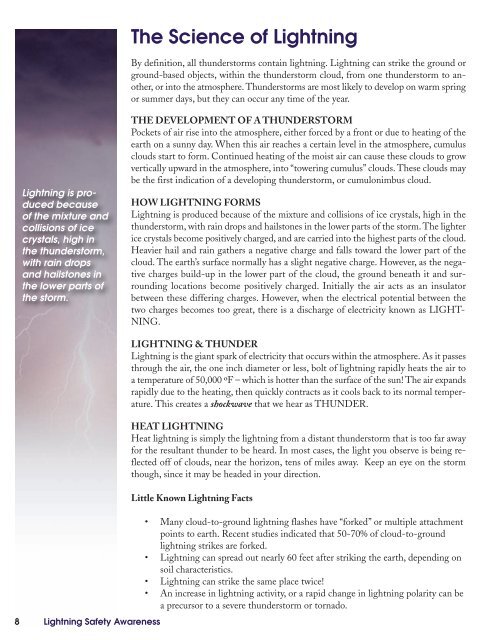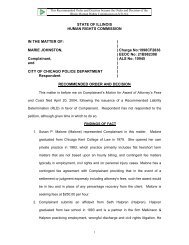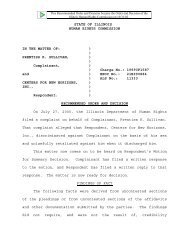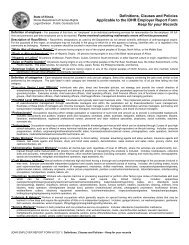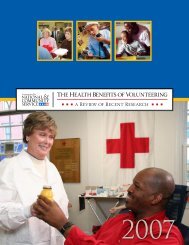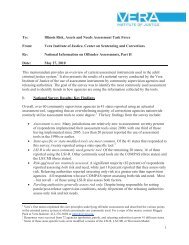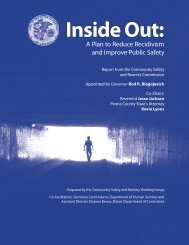lightning safety awareness booklet (PDF, 1.97 MB) - State of Illinois
lightning safety awareness booklet (PDF, 1.97 MB) - State of Illinois
lightning safety awareness booklet (PDF, 1.97 MB) - State of Illinois
You also want an ePaper? Increase the reach of your titles
YUMPU automatically turns print PDFs into web optimized ePapers that Google loves.
The Science <strong>of</strong> LightningBy definition, all thunderstorms contain <strong>lightning</strong>. Lightning can strike the ground orground-based objects, within the thunderstorm cloud, from one thunderstorm to another,or into the atmosphere. Thunderstorms are most likely to develop on warm springor summer days, but they can occur any time <strong>of</strong> the year.Lightning is producedbecause<strong>of</strong> the mixture andcollisions <strong>of</strong> icecrystals, high inthe thunderstorm,with rain dropsand hailstones inthe lower parts <strong>of</strong>the storm.THE DEVELOPMENT OF A THUNDERSTORMPockets <strong>of</strong> air rise into the atmosphere, either forced by a front or due to heating <strong>of</strong> theearth on a sunny day. When this air reaches a certain level in the atmosphere, cumulusclouds start to form. Continued heating <strong>of</strong> the moist air can cause these clouds to growvertically upward in the atmosphere, into “towering cumulus” clouds. These clouds maybe the first indication <strong>of</strong> a developing thunderstorm, or cumulonimbus cloud.HOW LIGHTNING FORMSLightning is produced because <strong>of</strong> the mixture and collisions <strong>of</strong> ice crystals, high in thethunderstorm, with rain drops and hailstones in the lower parts <strong>of</strong> the storm. The lighterice crystals become positively charged, and are carried into the highest parts <strong>of</strong> the cloud.Heavier hail and rain gathers a negative charge and falls toward the lower part <strong>of</strong> thecloud. The earth’s surface normally has a slight negative charge. However, as the negativecharges build-up in the lower part <strong>of</strong> the cloud, the ground beneath it and surroundinglocations become positively charged. Initially the air acts as an insulatorbetween these differing charges. However, when the electrical potential between thetwo charges becomes too great, there is a discharge <strong>of</strong> electricity known as LIGHT-NING.8 Lightning Safety AwarenessLIGHTNING & THUNDERLightning is the giant spark <strong>of</strong> electricity that occurs within the atmosphere. As it passesthrough the air, the one inch diameter or less, bolt <strong>of</strong> <strong>lightning</strong> rapidly heats the air toa temperature <strong>of</strong> 50,000 ºF – which is hotter than the surface <strong>of</strong> the sun! The air expandsrapidly due to the heating, then quickly contracts as it cools back to its normal temperature.This creates a shockwave that we hear as THUNDER.HEAT LIGHTNINGHeat <strong>lightning</strong> is simply the <strong>lightning</strong> from a distant thunderstorm that is too far awayfor the resultant thunder to be heard. In most cases, the light you observe is being reflected<strong>of</strong>f <strong>of</strong> clouds, near the horizon, tens <strong>of</strong> miles away. Keep an eye on the stormthough, since it may be headed in your direction.Little Known Lightning Facts• Many cloud-to-ground <strong>lightning</strong> flashes have “forked” or multiple attachmentpoints to earth. Recent studies indicated that 50-70% <strong>of</strong> cloud-to-ground<strong>lightning</strong> strikes are forked.• Lightning can spread out nearly 60 feet after striking the earth, depending onsoil characteristics.• Lightning can strike the same place twice!• An increase in <strong>lightning</strong> activity, or a rapid change in <strong>lightning</strong> polarity can bea precursor to a severe thunderstorm or tornado.


